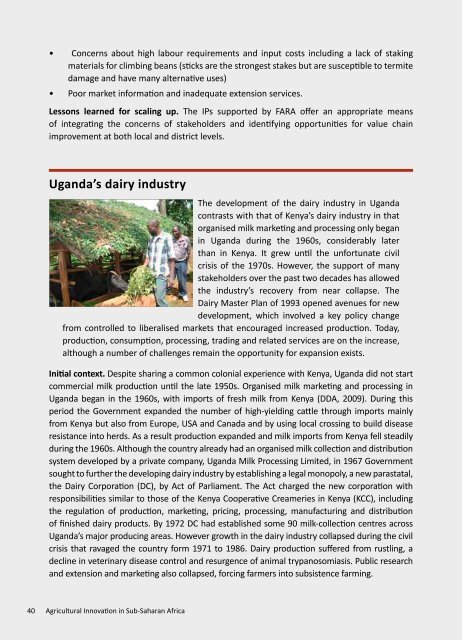1C1KKTs
1C1KKTs
1C1KKTs
You also want an ePaper? Increase the reach of your titles
YUMPU automatically turns print PDFs into web optimized ePapers that Google loves.
• Concerns about high labour requirements and input costs including a lack of staking<br />
materials for climbing beans (sticks are the strongest stakes but are susceptible to termite<br />
damage and have many alternative uses)<br />
• Poor market information and inadequate extension services.<br />
Lessons learned for scaling up. The IPs supported by FARA offer an appropriate means<br />
of integrating the concerns of stakeholders and identifying opportunities for value chain<br />
improvement at both local and district levels.<br />
Uganda’s dairy industry<br />
The development of the dairy industry in Uganda<br />
contrasts with that of Kenya’s dairy industry in that<br />
organised milk marketing and processing only began<br />
in Uganda during the 1960s, considerably later<br />
than in Kenya. It grew until the unfortunate civil<br />
crisis of the 1970s. However, the support of many<br />
stakeholders over the past two decades has allowed<br />
the industry’s recovery from near collapse. The<br />
Dairy Master Plan of 1993 opened avenues for new<br />
development, which involved a key policy change<br />
from controlled to liberalised markets that encouraged increased production. Today,<br />
production, consumption, processing, trading and related services are on the increase,<br />
although a number of challenges remain the opportunity for expansion exists.<br />
Initial context. Despite sharing a common colonial experience with Kenya, Uganda did not start<br />
commercial milk production until the late 1950s. Organised milk marketing and processing in<br />
Uganda began in the 1960s, with imports of fresh milk from Kenya (DDA, 2009). During this<br />
period the Government expanded the number of high-yielding cattle through imports mainly<br />
from Kenya but also from Europe, USA and Canada and by using local crossing to build disease<br />
resistance into herds. As a result production expanded and milk imports from Kenya fell steadily<br />
during the 1960s. Although the country already had an organised milk collection and distribution<br />
system developed by a private company, Uganda Milk Processing Limited, in 1967 Government<br />
sought to further the developing dairy industry by establishing a legal monopoly, a new parastatal,<br />
the Dairy Corporation (DC), by Act of Parliament. The Act charged the new corporation with<br />
responsibilities similar to those of the Kenya Cooperative Creameries in Kenya (KCC), including<br />
the regulation of production, marketing, pricing, processing, manufacturing and distribution<br />
of finished dairy products. By 1972 DC had established some 90 milk-collection centres across<br />
Uganda’s major producing areas. However growth in the dairy industry collapsed during the civil<br />
crisis that ravaged the country form 1971 to 1986. Dairy production suffered from rustling, a<br />
decline in veterinary disease control and resurgence of animal trypanosomiasis. Public research<br />
and extension and marketing also collapsed, forcing farmers into subsistence farming.<br />
40 Agricultural Innovation in Sub-Saharan Africa


